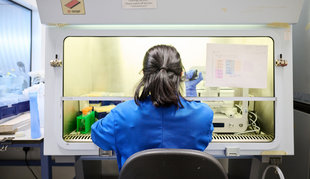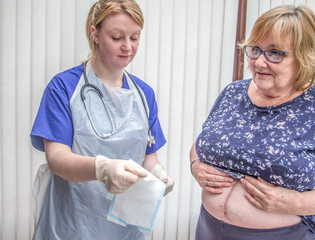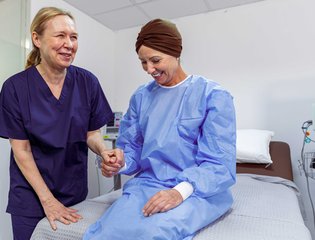How new ovarian cancer treatments become available

New treatments begin their journey in the research lab.
Ovarian Cancer Action is a community of changemakers with one purpose: to give ovarian cancer the focus it needs to increase 10-year survival rates. And we know research is the solution. We’ve funded over £13m in research projects since we began. But how long does it take for research to make it to a new treatment for patients?
Here we look at the process from lab to patient.
Drug discovery (Can take many years)
The process starts with experiments in the lab to discover new ways of treating a condition. Out of many potential new ideas, only the most promising move onto the next stage.
Pre-clinical stage (1-2 years)
Before any drug can be used in human trials, it has to be tested carefully to make sure it won’t cause harm. Scientists use pre-clinical models, such as testing on human cells in a petri dish, in animals1, or using computer models, to study safety and the potential dose needed.
Phase 1 clinical trials - Safety (Around 1 year)
This phase involves the first tests on humans and is looking at safety, dosage, and the best way to deliver the drug (e.g. through a drip or by a tablet you swallow).
The numbers involved are usually 20-100 people, who may be healthy volunteers.
There’s around 60% chance of drug trials moving onto phase 2.
Phase 2 clinical trials – How it reacts (Around 2-4 years)
In this phase, researchers are gathering more data on any side effects and how effective the drug is at what it is aiming to do, for example killing cancer cells.
This phase involves 100-300 people who have the condition.
Around 30% of drugs will move onto phase 3.
Phase 3 clinical trials – Efficacy (2-4 years)
This phase is about confirming that the drug is effective and examining side effects over a longer time period. It also involves comparing the drug to other treatments or placebo.
This phase can involve hundreds to thousands of people. There’s around 50% chance that drugs in this phase will move on to apply for market approval.
Marketing authorisation/ licensing (6 months - 1 year)
A drug must have a license before it can be made available to treat a specific condition.
The Medicines and Healthcare Products Regulatory Agency (MHRA) reviews the evidence from clinical trials to make sure the drug is safe and effective, and that the benefits outweigh any side effects. The MHRA carries out the reviews of drugs for England, Wales and Scotland. Northern Ireland follows recommendations from the European Medicines Agency (EMA).
Overall, in cancer drug development, around 5% of drugs that start phase 1 trials make it through all the next phases and get market approval. On average, it takes ten years for a phase 1 drug to reach market approval.
Some of the barriers to drugs making it from the ideas stage to patients include:
- A lack of funding for discovery and pre-clinical stage research
- Just because something works in pre-clinical models, it doesn’t always translate to having the same benefit for humans. So even drugs that look promising to start with aren’t effective or safe enough to progress through to later-stage trials
- Challenges of recruiting very specific patients to clinical trials
Funding on NHS (1-2 years)
After a drug has been licensed, it is then assessed to decide whether it will be available as part of the free healthcare service in each of the devolved nations. There is a set process for looking at how effective the drug is, its safety and how much it costs. The process also involves including patient perspectives to help choose treatments that will have the most impact. Organisations like Ovarian Cancer Action are asked to contribute by collecting and sharing patient views, and also by supporting patient advocates to be experts at the meetings where the deciding panel hears evidence.
In England, the National Institute for Health and Care Excellence (NICE) assesses the evidence and decides whether to fund the drug on the NHS.
In Wales, the All Wales Medicines Strategy Group (AWMSG) assesses whether the NHS will fund the drug. This usually follows NICE guidance and there will not be a separate assessment if there is a NICE assessment planned.
In Northern Ireland, the Department of Health, Social Services and Public Safety (DHSSPS) looks at NICE guidance to decide whether to follow their decision and fund the drug on the HSC. Usually, the NICE guidance is followed.
In Scotland, the Scottish Medicines Consortium (SMC) assesses drugs to decide whether they will be funded on the NHS. This is a completely different process and timeline to NICE and so does not automatically follow NICE guidance.
What does it mean for a drug to be used “off label”?
When the regulatory bodies decide whether to approve a drug (also known as licensing it) this is only for the condition listed, with a set dose and specific delivery method (e.g. tablets or through a drip).
As you may see for drugs used in ovarian cancer, the approval is specific to the subtype of ovarian cancer (for example high-grade serous), the stage of disease, and certain genetic markers (for example, BRCA or HRD status).
“Off-label prescribing” is when a doctor prescribes a drug for a different use to the one granted in the license, having weighed up the pros and cons and deciding it is in the best interests of the patient. The doctor takes on full responsibility for the outcome.
For example, this might be because the medicine has been studied and found to be effective for your condition, but the company hasn’t applied for a license for that specific situation yet, or they are waiting on the licensing process to be complete.
How can I access drugs that aren’t yet available on the NHS?
The first thing to do is to speak to your cancer team to find out what your options are and why certain treatments might not be the right in your situation. There may be a reason why a different option would suit you better, and this is very individual so don’t worry if someone else in a similar situation has a different treatment plan.
If you think there is a treatment that would be the best option for you but it is not available, your cancer team will be able to talk you through the following options:
Individual funding request (IFR)
This request has to be made by your doctor. Your doctor will have to explain why your medical circumstances are unique or different to others with the same diagnosis, and why you would benefit more from the treatment. This is based only on your clinical information, not on any personal, family, or financial situation.
This is then considered by an independent panel.
Early access to medicines scheme (EAMS)
If there is no treatment option available to a patient with a life-threatening or seriously debilitating condition it may be possible to apply for access to an unlicensed treatment, that is not yet approved or still being researched, through this scheme.
Your doctor will have to apply to this scheme and detail the situation, the unmet need, and why the treatment would be the best option for you.
Cancer Drugs Fund
In England, the Cancer Drugs Fund (CDF) is part of the process for approving new medications. The CDF gives access to treatments when there is promising data available on how well the drug works, but more evidence is needed to approve it. This means people can take the drug earlier, while more data is gathered over a period of around two years.
The CDF also provides access to drugs for a short period when they have first been approved, while the decision is confirmed and the drug becomes routinely available.
In Northern Ireland, the HSCS follows the NICE CDF decisions.
In Wales the New Treatment Fund (NTF) aims to shorten the timeline for new medicines being available for patients. It provides funding for those recommended by the All Wales Medicines Strategy Group (AWMSG) and the CDF in England.
In Scotland, the New Medicine’s Fund (NMF) covers the cost of new medications for patients, particularly end-of-life treatments and drugs for people with rare diseases.
Private healthcare
It may be possible to access some treatments through private healthcare, either through private health insurance or paying for it yourself.
You can continue to have NHS treatment while paying for additional treatment privately, but this has to be given separately to the private treatment.
If you are considering this you can speak to your consultant about whether they do private work and what they would suggest in your situation, or you can consult with another specialist at a private hospital. It’s important to understand why a treatment isn’t approved for your situation, and what the risks and benefits are.
Clinical trials
Being part of a clinical trial involves you signing up to be part of a research study that is looking into the effectiveness of a drug that has not yet been approved or has not been approved in your exact situation. Your cancer team will be able to tell you about any clinical trials that might be suitable for you.
There are usually very specific eligibility criteria that you have to meet for each trial, and you may have to travel to a different hospital to get involved.
You can find out more about clinical trials here https://ovarian.org.uk/ovarian-cancer/living-with-ovarian-cancer/ovarian-cancer-treatment/clinical-trials/


